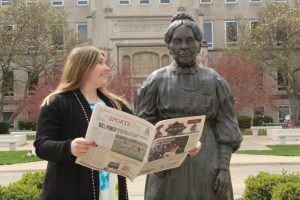Twice in the span of one week, suspects considered dangerous by Peoria law officials have been on or near Bradley’s campus.
And twice in the span of one week, I’ve been disappointed with the way the university handled the situations.
In each incident, though students were alerted to guard their safety, the information we received was either too little or too late.
Two inmates were discovered missing from the Peoria County Jail about 7 a.m. on Tuesday. The jail is roughly five miles from Bradley’s campus, and both men are considered dangerous.
One inmate, James E. Fuller, was awaiting trial on charges including home invasion and criminal sexual assault with force. He raped a 52-year-old widow twice in 2006 during a spree of sexual assaults, ending with an attempt to assault a West Peoria woman on Callender Avenue.
The other, Aaron Cook, was jailed on charges of aggravated battery of a child, obstructing justice and theft.
The inmates were discovered missing early Tuesday morning, but for some reason, though our campus is only five miles from the jail, students didn’t receive any information from the university until about 2:15 p.m on Tuesday – six hours after the inmates were discovered missing.
Does anyone else see a problem with that?
If an incident warrants an alert to be sent to the entire Bradley community, shouldn’t that alert be timely?
Six hours is plenty of time to move five miles on foot. These guys could have breezed through our area already. Someone could have gotten hurt (worst case scenario) or spotted them and alerted police (best case scenario). But receiving the information only a couple hours before nightfall won’t help us identify anything suspicious or protect our own safety.
I thought the university learned with Bradley’s last brush with a criminal, exactly one week prior to Tuesday’s situation.
The details of this situation are well-known by now: on Nov. 10, two men armed with handguns tied up an employee of Buffalo Wild Wings near the Shoppes at Grand Prairie, then robbed him of his cell phone and wallet. They then activated a stun gun on another employee’s arm before fleeing in a car. The chase ended just north of St. James Street, near the Caterpillar Global Communications Center.
The passenger in the car was arrested – but the driver fled on foot in the area.
The incident occurred about 1 a.m. that morning. Those signed up for the ForeWarn emergency notification system didn’t receive information until after 2:30 a.m., about an hour and a half later. Even then, the information was brief, just stating that a robbery suspect was in the area and students should remain inside.
When I received an e-mail about the incident later that morning, around 6 a.m., I thought we’d finally have more details.
But the e-mail was just as vague, advising students to use caution, but reassuring that the immediate danger had passed. There was no description of the suspect, no information on where the incident occurred – really, no details at all.
The lack of information on the university’s part bothered me on Nov. 10, but I chalked it up to being unprepared for an emergency. But now that a similar situation that could affect students’ safety has occurred only a week later, I can’t attribute it to inexperience any longer.
Students need to be informed quickly if our safety is at risk, no matter what the means.
A text message more than an hour after an incident, or an e-mail six hours after an incident, both lacking in detail and offering little to understand, aren’t helpful. They just scare and anger students into feeling left in the dark.
The university needs to make a better effort in informing students of incidents on and around campus. This doesn’t just mean alerting us in a timely manner – it means including relevant information that could not only protect our safety, but also possibly help lead to arrests.
Lauren Rees is a senior journalism major from Schaumburg. She is a Scout staff reporter.
Direct comments, questions and other responses to lrees@mail.bradley.edu.



